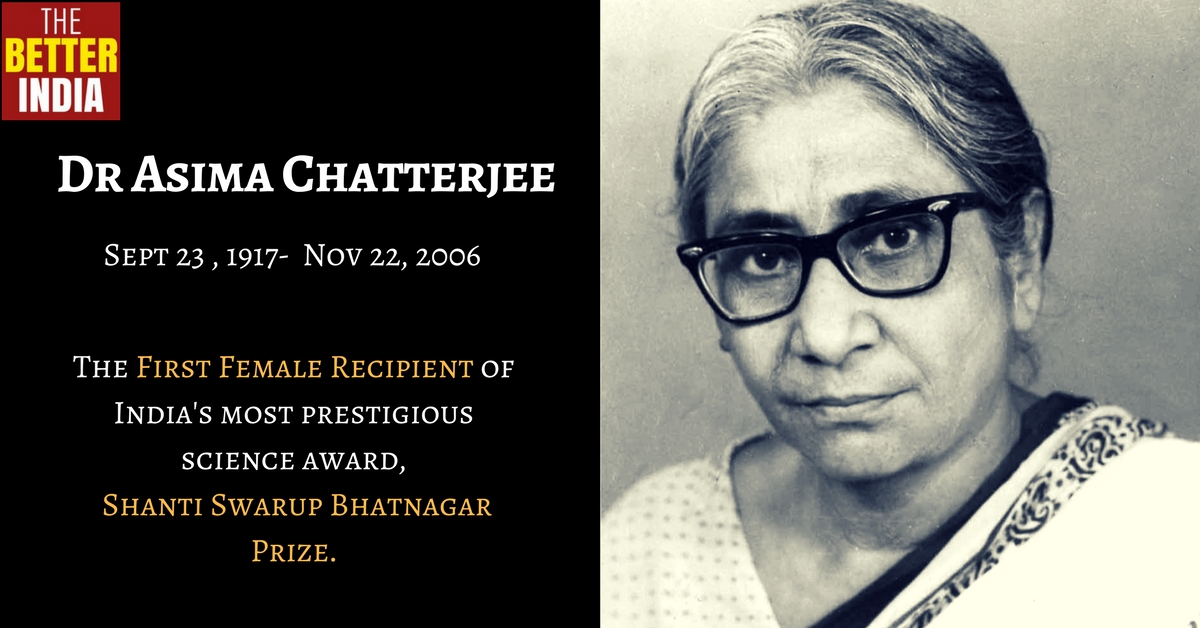Asima Chatterjee: All You Need to Know About One of India’s First Woman Doctorates of Science!
Born on September 23, 1917, Asima Chatterjee, was one of the first Indian women to earn a doctorate in science in British India. She paved the way for Indian women to pursue organic chemistry and opened the world’s eyes to the power of medicinal plants.

Google celebrated Asima Chatterjee’s 100th birthday with a special doodle tribute to her. This serene bespectacled woman, a world-class scientist, once said, “I wish to work as long as I live.”
Born on September 23, 1917, Asima Chatterjee, was one of the first Indian women to earn a doctorate in science in British India. She paved the way for Indian women to pursue organic chemistry and opened the world’s eyes to the power of medicinal plants.

Asima’s maiden name was Mokerjee. She grew up in a middle-class household in Calcutta and was the oldest of two children of Dr Indra Narayan Mookerjee and his wife, Kamala Devi.
Her younger brother, Sarashi Ranjan Mookerjee, also came to known as a noteworthy surgeon, and collaborated with Asima in her research on medicinal plants. It was her father’s love for botany that piqued Asima’s interest in their medicinal properties.
As a young girl, her parents never restricted Asima from pursuing education. She completed her graduation with honors in chemistry from the Scottish Church College of the University of Calcutta in 1936. She moved on to received a master’s degree in organic chemistry in 1938 from the University of Calcutta.
She became the second woman after Janaki Ammal to be earn a Doctorate of Science by an Indian University, i.e the University of Calcutta in 1944. She researched natural products chemistry and developed leading anti-convulsive, anti-malarial, and chemotherapy drugs.
One of her most successful anti-epileptic drug, ‘Ayush-56’ was developed from Marsilia minuta, while her anti-malarial drug was developed from Alstonia scholaris, Swrrtia chirata, Picrorphiza kurroa and Ceasalpinna crista.
She spent 40 long years researching a class of compounds called alkaloids. Some of these alkaloids are efficiently used during chemotherapy to prevent the multiplication of cells in cancer patients. These patented drugs have been widely marketed by several companies.
Asima also chemically analysed coumarins, which essentially came from the bael tree, a native species in India. It was she who brought to light that the fruits and bark of this tree could treat a variety of gastrointestinal disorders.
Read more: Meet Sailesh, Who Gave Up a Plush Corporate Job to Improve Elderly Healthcare
In association with Mr. Anjan Palit, a well known personality in chemistry, she became the founding head of the department of chemistry at Lady Brabourne College of the University of Calcutta. She joined the University College of Science of the University of Calcutta, as reader in pure chemistry in 1954.
Her numerous achievements include being a Premchand Roychand Scholar of the University of Calcutta and serving as the Khaira Professor of Chemistry (1962-1982, the most prestigious and coveted chairs of the University of Calcutta. 1960 marked her election as the Fellow of the Indian National Science Academy, New Delhi.
The following year, she became the first female recipient of the country’s most prestigious science award, the annual Shanti Swarup Bhatnagar Prize.
Even though the award was first introduced in 1958, but it wasn’t until 1960, that the ‘chemical sciences’ category was introduced. Asima won the award for her contribution and achievements in phytomedicine (the study of plant extracts for therapy). It took over 14 years for another woman to win the same prize, and over 48 years for a woman to win it in the ‘chemical sciences’ category.
In 1972, Asima was appointed the Honorary Coordinator of the Special Assistance Programme to intensify teaching and research in natural product chemistry, sanctioned by the University Grants Commission (India).
She was conferred the prestigious Padma Bhushan in 1975. She also became the first lady scientist to be elected as the General President of the Indian Science Congress Association .
She was nominated by the President of India as a Member of the Rajya Sabha from February 1982 to May 1990. She left for her heavenly abode on November 22, 2006.
In her lifetime, she published over 400 papers on Indian medicinal plants and their chemistry.
Ashima may have gone, but her legacy continues to live on.
Like this story? Or have something to share?
Write to us: [email protected]
Connect with us on Facebook and Twitter.
NEW: Click here to get positive news on WhatsApp!
If you found our stories insightful, informative, or even just enjoyable, we invite you to consider making a voluntary payment to support the work we do at The Better India. Your contribution helps us continue producing quality content that educates, inspires, and drives positive change.
Choose one of the payment options below for your contribution-
By paying for the stories you value, you directly contribute to sustaining our efforts focused on making a difference in the world. Together, let’s ensure that impactful stories continue to be told and shared, enriching lives and communities alike.
Thank you for your support. Here are some frequently asked questions you might find helpful to know why you are contributing?


This story made me
-
97
-
121
-
89
-
167











